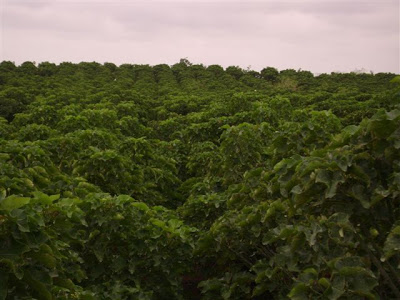Following my recent post on the energy situation in India, I received an e-mail from Sreenivas Ghatty, the founder and CEO of Tree Oils India. Sreenivas told me that I was correct that the jatropha situation in India has been overstated, and wanted to provide some facts on where jatropha stands. Sreenivas is involved in trying to establish a jatropha industry, and he wrote in part:
There are no large scale commercial plantations in India as of now. The plantation activity has commenced here and there during the last few years, but, it may take few more years before the commercial yields start. We have been focusing on research to improve yields and expect meaningful outcomes this year. Based on the results, we intend to expand plantation on our own and through contract farming in the next few years.
Jatropha is not panacea to feedstock problems. It has limitations and would fail under certain agro climatic conditions. There are other species such as Pongamia, Moringa, Madhuca and Neem which could perform well where Jatropha could fail. If right species and right plantation material are selected and the right agronomic practices are adopted, the results might be profitable, viable and sustainable to all the stakeholders.
He also provided some pictures from a jatropha plantation which were very interesting:
Sreenivas also pointed me to an interview he had given on his biofuel activities:
His cites peak oil as a reason for becoming interested in this area:
Why BioFuels?
With peak oil approaching faster, alternative energy sources need to be developed. Biofuels are the cheapest and the most sustainable alternative and they can be produced and consumed locally by many people in small quantities. Alongside, there are also benefits to economy and environment.
And he doesn’t make outrageous claims regarding the costs:
What could be the price of fuel using these feed stocks?
Under the circumstances, it cannot be less than $2 per litre.
The bottom line is that jatropha and other non-edible oil plantations are being established, but 1). It’s going to take time; 2). The fuel that is produced may all be consumed locally.



Interesting about the cost. I came to roughly the same number for jatropha fuel in Thailand. However, the Chinese government is going ahead with two, possibly three, million hectare plantations in Indonesia. Perhaps there are economies of scale.
Also, the fact that jatropha will be consumed locally is great…still less demand on world markets. Oil is a fungible commodity.
Now, back to those diesel trees….if you can wait long enough, the lack of real labor costs in collecting fuel from diesel trees is very attractive…jatropha requires labor to collect and then put through an impeller (squeezer) to get the juice out….the problem is diesel trres may take years and years to mature….
Anyone else find the irony in the selection from Ads by Google at the bottom of this piece.
At least for me: Run your car on wood! Stop paying high gas prices!
I think I’ll take my advice from RR rather than the ad.
“At least for me: Run your car on wood! Stop paying high gas prices!”
It is possible,believe it or not. I read up on wood alcohol after my buddy told me his landfill costs run $20,000 plus a year. He’s an arborist,and all he dumps is trees and branches,at $40 per ton. He does split what he can,and sells wood by the cord during the winter. Still,it’s a terrible waste,especially when you consider he’s just one of dozens of arborists in the area.
My friend burns a lot of gas in his business. Wood alcohol is just methane,so I looked into the possibility of converting his engines to methane. It turns out modern engines don’t do so well with methane. It corrodes aluminum and rubber. I am surprised there aren’t entrepreneurs out there generating electricity from waste wood methanol. A lot of folks would gladly give them the fuel stock.
Also given that cultivars are still being tested and plantations established the realistic data on oil yeild especially with geographic and weather variations is very small.
Studies based on high yields and strongly linked to drought resistance and the use of marginal land in new areas, need to be evaluated with caution.
Good to know that the Indian researchers and farmers are still working on matching the energy crop to the growing region. Biomass and biofuel solutions have to be local and regional, not global.
The US government approach to mandating one biofuel over other approaches nationally, is exactly backwards. They compound the problem by slapping tariffs on imported ethanol.
Run your car on wood! Stop paying high gas prices!
Conversions to wood and coal were pretty common in WW2 Europe. People would install a small gasifier and connect its output to the carburettor or intake manifold. Not ideal, but it got you from point A to point B.
To Maury: Wood alcohol is methanol, not methane.
I am surprised there aren’t entrepreneurs out there generating electricity from waste wood methanol.
Why on earth would you do that? If you’re going to make electricity from wood, burn or gasify the stuff directly!
National Geographic had a piece on it recently: http://news.nationalgeographic.com/news/2008/04/
080421-biofuels.html